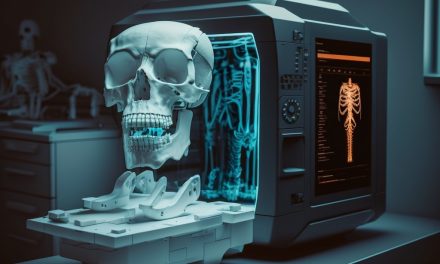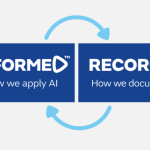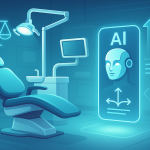AI Solutions to Streamline Dental Practice Operations & Improve Patient Care
There is an understandable focus on the exciting developments in artificial intelligence (AI) and other advanced technology solutions for diagnostics and other aspects of clinical dental care. Meanwhile, dental practice operations and administration can also greatly benefit from the adoption of AI to improve practice efficiency, staff retention and patient satisfaction.
Based on the findings of multiple studies into technology adoption in dental practices, those that adopt more technology solutions are likely to have the following characteristics: be larger practices or chains of clinics; have younger dental professionals; be newer practices; be located in urban areas and generate higher revenue. However, the benefits of AI in improving practice management are available to, and would benefit practices of all sizes and configurations.
In this article, five key challenges in dental practice management are identified: 1. appointment scheduling 2. billing and insurance claims 3. managing patient records 4. predictive analytics, and 5. inventory management. Suggestions about how AI or other advanced digital tools and technologies can solve or help address each challenge in order to provide dentists with competitive advantage are discussed. Finally, an indicative cost and effort analysis conducted for three sizes of dental practice. The goal of this is to help dental professionals make a more informed decision about whether, and at what level of adoption to engage with the benefits AI has for dental practice management.
1. AI Streamlines Appointments for Dental Practices
Scheduling appointments is a challenge for dental practices as it can be time-consuming and prone to errors. This can lead to overbooking, double-booking, or missed appointments, which can negatively impact the practice’s revenue and reputation. Whilst most Australian practices use electronic scheduling systems, these systems are usually stand-alone IT systems. They are also not optimised for natural language input, which makes it harder for users to find the required information.
To address this challenge, dental practices can use tools considered to be part of dental informatics, the application of information technology to dentistry. Advanced AI tools such as natural language processing (NLP) can be used to automate the process of scheduling appointments via chatbots or virtual assistants.
Patients can use the practice’s website or mobile app to request an appointment using natural language, such as “I would like to schedule a hygiene appointment next Wednesday at 2pm.” The chatbot or virtual assistant, powered by NLP, can understand the request and check the practice’s schedule for availability. If the desired time slot is available, the appointment can be scheduled automatically. If the desired time slot is not available, the chatbot or virtual assistant can offer alternative options for the patient to choose from.
These systems can also integrate with electronic health records (EHRs) and other information systems, allowing dental professionals to access patient information and appointment history in real-time. This can improve the patient experience by reducing wait times. Additionally, these systems can also provide features like automated appointment reminders and rescheduling options, which can further improve the patient experience and reduce the administrative workload for dental practices.
2. Billing and Insurance Claims: Simplify with AI
Dental billing and invoicing can be a complex process, and electronic billing systems are commonly used by dentists in Australia. These electronic billing systems are sometimes integrated with dental practice management software, and this enables dentists to submit claims to a variety of payers, including private health insurance companies and government programs like the Child Dental Benefits Schedule (CDBS).
Dental practices can enhance their billing and claims processing by using machine learning algorithms to automate these processes. This can be done by integrating the practice’s billing and insurance data with an AI-powered software that can automatically process claims and identify errors or discrepancies, such as missing information or incorrect codes, as they are submitted. The software can then flag these errors for the practice’s billing team to review and correct before submission, thereby speeding payment times and reducing manual follow ups.
3. Patient Records: Improve Care using AI
Dental practices currently rely on electronic health record (EHR) systems to manage patient records, but these systems are often not optimised for natural language input or for creating detailed, accurate patient profiles. A significant proportion of dental practices still use manual methods, which can be difficult to manage and prone to errors.
Digital imaging systems are increasingly common in Australian dental practices, to capture and manage radiographic images, such as X-rays, enabling dentists to view high-resolution images on computer screens, rather than relying on film-based X-rays. An ideal next step is to integrate these imaging systems with patients’ EHRs, allowing dentists to view patient images alongside their medical and dental history.
In addition, dental practices can utilise the power of natural language processing (NLP) to automate the process of managing patient records. This can be done by integrating an NLP-powered software into the practice’s EHR system, which can extract information from patient records and create detailed, accurate patient profiles. This can improve patient care and reduce the risk of errors.
On a daily basis, the NLP-powered software can automatically extract information from patient records as they are entered into the EHR system. The software can understand the information and create detailed, accurate patient profiles. This can help dental professionals have a complete, up-to-date and accurate picture of their patients’ health to make fully informed decisions.
It’s worth noting that the use of electronic systems for managing dental patient records is regulated in Australia by the Australian Dental Council (ADC) and the Dental Board of Australia (DBA) to ensure patient information is kept secure and confidential. Additionally, dental practices are required to comply with the National Privacy Principles (NPPs) as well as the Health Insurance Act 1973 and the Privacy Act 1988, which set out the rules for the handling of personal information.
4. Predictive Analytics: Plan patient care with AI
Gaining insights into patient behaviour, treatment outcomes, and revenue potential is a challenge for dental practices as it can be difficult to analyse large amounts of data without the requisite tools and/or training. This can lead to suboptimal treatment decision making and lost revenue. Currently, some dental practices may use data analysis tools, but they lack the capability to predict future trends and patient behaviour. Some practices may also use manual methods to gain insights into patient behaviour, treatment outcomes, and revenue potential, but these methods can be time-consuming and may not provide accurate or complete information.
To address this challenge, dental practices can use predictive analytics and AI to gain insights. This can be done by integrating the practice’s data, such as patient records, billing and insurance claims, and appointment schedules, with an AI-powered predictive analytics software. The software can then analyse the data to identify patterns and predict future trends. This can help dental practices plan for the future and make more informed decisions.
The predictive analytics software can automatically analyse the practice’s data and provide insights into patient behaviour, treatment outcomes, and revenue potential. This can help dental practices make data-driven decisions, such as forecasting patient demand and identifying opportunities for revenue growth.
5. Inventory Management: Optimise with AI
Managing inventory of dental materials, equipment and drugs is a challenge for dental practices. Errors can lead to waste, excess inventory, and a shortage of necessary materials. Dental practices currently rely on manual inventory management methods, such as manual counting and record keeping. Some practices may use inventory management software, but these systems may not be integrated with the practice’s other systems and may not be optimised for identifying patterns in usage or optimising inventory levels.
To address this challenge, dental practices can use machine learning algorithms to automate the process of inventory management. This can be done by integrating the practice’s inventory data with an AI-powered software that can predict inventory needs, identify patterns in usage, and optimise inventory levels. This can help dental practices reduce waste, lower costs, and improve patient care. The AI-powered software can automatically analyse the practice’s inventory data and make predictions about future inventory needs. It can also identify patterns in usage and optimise inventory levels to ensure that the practice has the necessary materials on hand without excess inventory. This can provide the benefits of saving time and money and improving patient care.
Analysis of potential cost, difficulty and efficiency gains
In the table below, the practice size is defined according to the number of dentists in the practice, with small practices being 1-5 dentists, medium practices being 6-10 dentists, and large practices being 11 or more dentists. The table provides information on the implementation cost, efficiency, patient benefit, and difficulty of implementing the AI solutions for each practice size.

It’s important to note that these are estimates and may vary depending on the specific implementation and practice, but may provide some useful guidelines for decision-making regarding investment in technology upgrades for your practice.
Software programmes that use the power of AI
Dentrix and Open Dental, are capable of handling both electronic health records (EHR) and practice management functions, making them suitable for various practice sizes.
Dentrix: Dentrix is suitable for all practice sizes, as it offers both basic and advanced features, making it a good choice for both small and large practices.
Open Dental: This software is a good choice for small to medium sized practices, as it offers a user-friendly interface and a range of features at an affordable price point.
It’s important to note that the appropriateness of a software depends on the specific needs and requirements of a practice. It’s always recommended to carefully evaluate the software’s features and capabilities before making a decision.
AI’s Impact on the Future of Dental Practice Management
In the coming years, the dental profession can expect to see continued advancements in AI technology and its applications in dental practice management. Some specific areas of development may include:
- Improved natural language processing (NLP) and machine learning algorithms that can better understand patient requests and provide more accurate and efficient appointment scheduling, billing and insurance claims processing, and patient record management.
- More advanced predictive analytics tools that can provide deeper insights into patient behaviour, treatment outcomes, and revenue potential, and help dental practices better plan for the future and make more informed decisions.
- Increased use of chatbots and virtual assistants that can help automate patient communication and provide more convenient and efficient service.
Overall, the dental profession can expect to see more AI-powered tools and technologies that will help automate time-consuming tasks and improve dental practice operations and management, providing dental practices with more efficiencies, cost savings and competitive advantages.
Conclusion
Dental practice management is a critical aspect of running a successful dental practice. The article highlights several key areas including patient experience, marketing, finances, staffing, and technology. To maximise the success of a dental practice, it is important to prioritise patient satisfaction, effectively market services, manage finances efficiently, hire and retain the right staff, and stay up to date with technology advancements. A well-rounded approach to these aspects can lead to a thriving dental practice.
Sources
- Lo Nigro, G.; Bizzoca, M.E.; Lo Muzio, L.; Campisi, G. The Management of Dental Practices in the Post-COVID 19 Era: An Economic and Operational Perspective. Int. J. Environ. Res. Public Health 2020, 17, 8905. https://doi.org/10.3390/ijerph17238905
- Alrahbi, Dana Abdullah, et al. “Exploring the Motivators of Technology Adoption in Healthcare.” International Journal of Healthcare Management, Jan. 2021. Informa, https://doi.org/10.1080/20479700.2019.1607451.
- Proffitt, E. What will be the new normal for the dental industry?. Br Dent J 228, 678–680 (2020). https://doi.org/10.1038/s41415-020-1583-x
- https://www.rolandberger.com/en/Insights/Publications/The-Future-of-Dentistry-is-Digital.html
- Betty Ladley Finkbeiner, Charles Allan Finkbeiner, (2020). Practice Management for the Dental Team, Elsevier
- Mühlemann, Sven; Sandrini, Gloria; Ioannidis, Alexis; Jung, Ronald E; Hämmerle, Christoph H F (2019). The use of digital technologies in dental practices in Switzerland: a cross-sectional survey. Swiss Dental Journal, 129(9):700-707
Author
Michelle Mason
m.r.mason04@gmail.com












